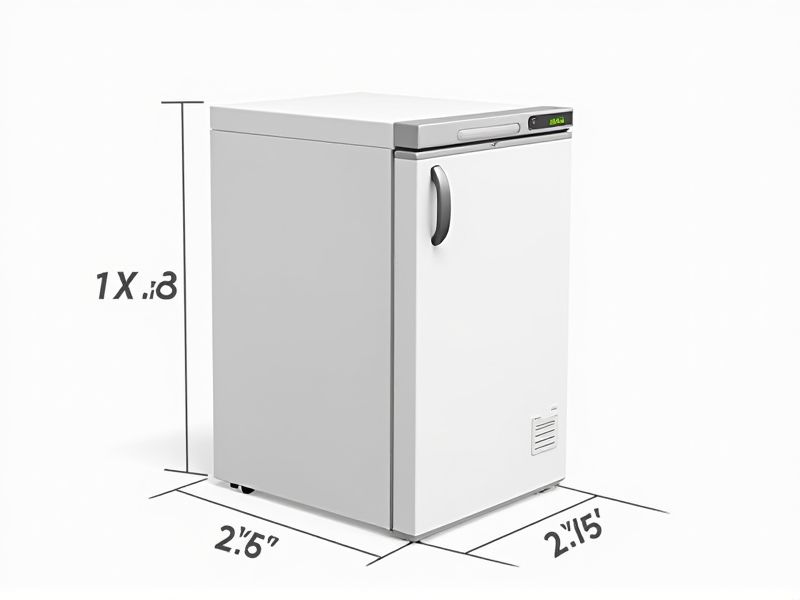
When choosing a freezer, knowing the standard dimensions helps ensure a proper fit in your available space. Upright freezers typically measure around 60-70 inches in height, 28-34 inches in width, and 25-32 inches in depth. Chest freezers, on the other hand, often range from 21-33 inches in height, 32-54 inches in width, and 22-30 inches in depth, depending on their capacity. Always check the manufacturer's specifications, as sizes can vary slightly between brands and models, and consider extra clearance for ventilation and door opening.
Width
When selecting a freezer, the width is a critical factor to consider, as it typically ranges from 24 inches to 36 inches. A standard width of 30 inches accommodates most kitchen spaces while providing ample storage capacity, often between 14 to 21 cubic feet. Ensure to measure your available space accurately, as a proper fit prevents operational issues and enhances overall efficiency. For optimal usage, consider your freezing needs, whether for bulk storage or everyday essentials.
Height
The ideal height for a standard freezer typically ranges between 60 to 72 inches, accommodating various kitchen layouts. A freezer with a height of around 70 inches often provides optimal storage capacity, allowing for more vertical organization of frozen items. Models that exceed this height may require more spacious kitchen environments or utility rooms. When selecting your freezer, ensure it fits well within the designated space while still offering easy access to shelves and bins.
Depth
The standard freezer depth typically ranges from 24 to 30 inches, accommodating both built-in and freestanding models. A depth of 28 inches is common for many household freezers, providing ample space for storage while remaining accessible in most kitchens. When considering a freezer, ensure that it fits your available space without obstructing airflow, which is essential for optimal performance. Your choice of freezer depth can significantly influence energy consumption, so look for energy-efficient models with proper insulation.
Capacity
When evaluating freezer capacity, consider that most household models range from 5 to 25 cubic feet, making them suitable for various storage needs. A smaller chest freezer, approximately 5 to 10 cubic feet, can hold around 175 to 350 pounds of food, ideal for limited space. For families or bulk shoppers, a larger upright freezer, typically 18 to 25 cubic feet, has the capacity to store 600 pounds or more, providing ample room for frozen goods. Your choice should reflect not just available space, but also consumption patterns and frequency of grocery shopping to ensure optimal efficiency.
Energy Efficiency
Modern freezers are often designed with a focus on energy efficiency, typically achieving an Energy Star rating. This certification indicates that they consume at least 10% less energy than non-rated models, leading to significant savings on electricity bills over time. For example, an efficient freezer can help reduce annual energy costs by approximately $50, depending on usage and local energy prices. By making an informed purchase, you can enhance your appliance's performance while contributing to a lower environmental footprint.
Shelving Configuration
The shelving configuration in a freezer significantly impacts its storage capacity and organization, ensuring optimal use of space. Most commercial freezers offer adjustable shelving options, allowing you to customize layout based on your products, which can range from 15 to 30 square feet of usable space. Proper shelving can improve air circulation, promoting even cooling across all levels and enhancing energy efficiency by up to 20%. When selecting a freezer, consider units with durable, easy-to-clean materials to maintain hygiene standards and prolong the lifespan of your investment.
Door Style
A freezer's door style significantly impacts its efficiency and accessibility, with common styles including French door, top freezer, and side-by-side configurations. French door models, featuring double doors on top and a pull-out drawer, maximize storage space while providing easy access to frozen items. Side-by-side models offer separate access to fresh and frozen compartments, ideal for compact kitchens, with widths typically ranging from 30 to 36 inches. Top freezer options, often more budget-friendly, maintain a classic design with the freezer compartment positioned above the refrigerator, making them a reliable choice for those prioritizing simplicity and storage capacity.
Defrost Mechanism
The defrost mechanism of modern freezers has evolved significantly, featuring advanced systems like automatic and manual defrost options. With automatic defrost, frost buildup is minimized, ensuring optimal storage temperatures and energy efficiency. This process typically occurs every 6 to 12 hours, depending on usage and design, reducing the need for manual clearing. You can expect to find efficient models that utilize fan-assisted cooling techniques to distribute air evenly, maintaining consistent temperatures throughout your freezer.
Noise Level
When selecting a freezer, paying attention to noise level is essential, especially for home settings. Freezers typically operate within a noise range of 35 to 45 decibels, with the quieter models being ideal for noise-sensitive environments. A noise level below 40 decibels is generally considered whisper-quiet, ensuring minimal disruption in your home. Be sure to check the manufacturer's specifications for detailed noise ratings to find a model that suits your preferences.
Temperature Range
The standard temperature range for a freezer typically falls between -10degF to -20degF (-23degC to -29degC), ensuring optimal food preservation. Most residential freezers maintain a consistent temperature of 0degF (-18degC) to halt bacterial growth and preserve the quality of frozen items. Commercial freezers may operate at even lower temperatures, reaching as low as -40degF (-40degC) for specific applications. You should regularly monitor the temperature to ensure that your freezer operates efficiently and maintains food safety.
